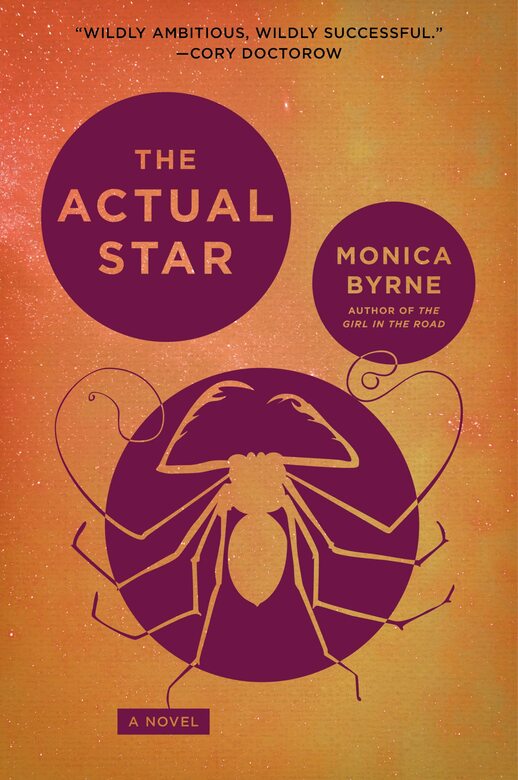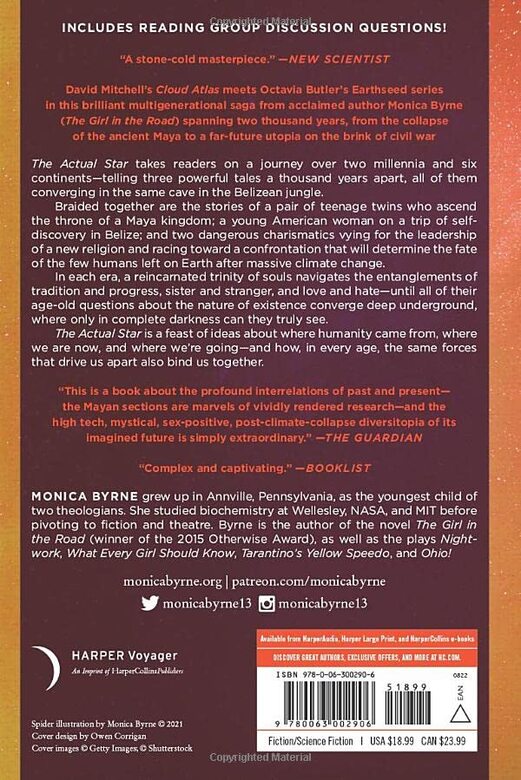The Most Ambitious SF Novel of 2021: The Actual Star by Monica Byrne
 |
 |
The Actual Star (Harper Voyager reprint edition, August 16, 2022). Cover art by Monica Byrne
The trick to really staying on top of the best SF and fantasy, I’ve found, is to take the time to find a handful of excellent reviewers, and trust what they tell you. I’ve discovered over long years that Rich Horton is one of the most reliable and discerning readers out there, and this is what he posted on Facebook three days ago.
I just finished reading (via listening to) The Actual Star, by Monica Byrne. I don’t think it’s perfect, but I will say it is way more ambitious than any other 2021 SF novel I’ve read, and I strongly think it deserved a Hugo nomination.
By strange coincidence, I’d just picked up a copy of the Harper Voyager paperback reprint of The Actual Star, and had a copy to hand. See how fate works for you when you let it?
Rich isn’t the only reader to notice The Actual Star; New Scientist called it “A stone-cold masterpiece,” and Ian Mond at Locus Online gushed, labeling it “a terrific novel.” My favorite long review comes from Tobias Carroll at Tor.com, who said in part:
In The Actual Star… parallel timelines makes use of an especially grand scale; a thousand years separates each of the three timeframes. They’re set in 1012, 2012, and 3012 CE, respectively; a constant motif in the novel is seeing how the events described in one part are faithfully (or not) remembered a millennium later. Complicating this somewhat is another recurring motif: that of a trio of characters who recur in each of the timeframes. Reincarnation is taken as a fact of life by the planetwide culture of the 3012 sections… Each of the three segments could stand on its own relatively well as a short novel; even so, the way these plotlines converge makes each one stronger…
In 1012, twins Ixul and Ajul, and their sister Ket, deal with the challenges of power and the twins’ pending rule over a Maya kingdom in what is now Belize. The dynamic between the three siblings is established quickly: The twins are enmeshed in a clandestine relationship, while Ket’s interests tend towards the more mystical. A thousand years after that, a young woman named Leah makes plans to leave her home in Minnesota to travel to Belize, where her father lived, and to explore Actun Tunichil Muknal, a sacred cave with a deep historical meaning. And a thousand years after that, in a world transformed by climate change — the novel’s prologue notes that “the last of the world’s ice is gone” — a philosophical debate between Niloux and Tanaaj, dueling political thinkers, threatens to upend society…
While the historical and present-day (well, present day minus nine years) segments are wholly compelling, it’s Byrne’s future society that stands out as a massive achievement. Laviaja, described in a glossary in the back of the novel as a “global system of nomadic, subsidiaries, anarchist self-organization,” is fascinating both for the extent to which it’s described, as well as for its rather unique place in science fiction: It’s a society set in the aftermath of a massive, even apocalyptic event that seems like somewhere you’d want to live…
This novel bristles with ambition, asks unfamiliar questions, and has one of the most effective examples of worldbuilding you’re likely to see on a page this year. It meticulously shapes its own territory, and draws a new map of what the genre can do — while rooting that in its characters’ own investigations into the world.
The Actual Star was published in hardcover last year, and reprinted in trade paperback by Harper Voyager on August 16, 2022. It is 610 pages, priced at $27.99 in hardcover, $18.99 in trade paperback, and $13.99 in digital formats. The cover art is by the author, Monica Byrne; the cover was designed by Owen Corrigan.
See all our coverage of the best new SF and Fantasy here.
Sounds intriguing!